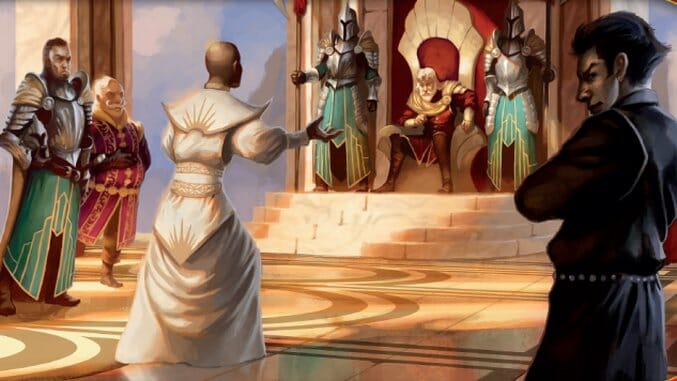Council of Blackthorn‘s Balancing Issues are Almost Treasonous

Council of Blackthorn is a highly interactive game for two to four players with a novel mechanic that forces players to pursue balanced strategies. Players try to use dice and play cards to move their tokens up four influence tracks, which gains them points but also enables them to use increasingly powerful cards to help themselves or steal things from their opponents. At the end of the game, the player with the most points wins unless that same player has the most points on Treason cards, in which case he’s the automatic loser—the one place where the game’s internal balance goes astray.
Players in Blackthorn are royal advisers fighting for influence with the king by way of four factions: the peasants, the legion (army), the guild (clergy), and the noble. Each player gets to choose one of six characters, each of which has some special actions or abilities that provide little (or occasionally big) benefits throughout the game, such as starting out above zero on one of the faction tracks, increasing the player’s maximum number of cards in hand, or allowing for the discard of certain Treason cards.
On a turn, a player rolls four dice, one in each color, with values from 0 to 3, and then chooses a card to play from his/her hand. Each card has a color as well, so the player moves up the influence track in that color/faction by the number on the die. If the value is 1 or 2, the player just moves up one or two places. If the value is 3, the player moves up 3 places but takes two Treason cards, each of which also has a value of 0 to 3, which are added up at game-end to determine who gets beheaded. (Figuratively.) Once per turn, each player may take one action from either his character card or one of his building cards as well. At the end of each turn, a player receives immediate points for leading on any faction tracks—two points for each track where s/he is alone in the lead, one if there’s a tie, so up to eight points per turn.
Each card also has a text effect, which can be immediate and one-time or ongoing, but a player can only use that text effect if the relevant die’s value is 0 or if the player matches the influence condition on the lower half of the card. That condition always involves a different faction than the color of the card, so the player has to have a certain level of influence in that second faction (usually between 2 and 5 on the track, depending on the power of the card). Some cards are discarded after playing, but others are Buildings, which remain in front of the player for the remainder of the game and confer up to 6 more victory points at game-end.
-

-

-

-

-

-

-

-

-

-

-

-

-

-

-

-

-

-

-

-

-

-

-

-

-

-

-

-

-

-

-

-

-

-

-

-

-

-

-

-









































